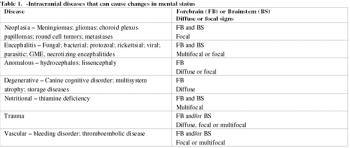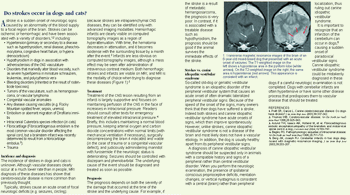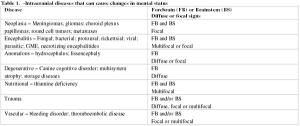
Neurons produce their effect by generating and propagating action potentials. In order to do this, they need to have adequate energy supplies (to maintain resting potential and axonal transport) and appropriate concentrations of electrolytes.
Natasha Olby, VetMB PhD, DACVIM (neurology)
Department of Clinical Sciences, College of Veterinary Medicine, North Carolina State University, Raleigh, NC 27606

Neurons produce their effect by generating and propagating action potentials. In order to do this, they need to have adequate energy supplies (to maintain resting potential and axonal transport) and appropriate concentrations of electrolytes.

Spinal pain is a common cause of morbidity in domestic pets, but can be frustrating to manage, particularly if the signs are episodic and never present when you see the patient! The pet owners may be more emotional about a painful pet than about other medical problems, and somewhat defensive about describing the signs.

Paraparesis is a common presenting sign in cats, but the differential diagnoses are less well known than for dogs. In addition, it can be challenging to perform a neurological examination in cats, making it more difficult to accurately localize the problem.

Over the last decade, the resources required to perform genetic studies in dogs have been developed and made available.

Evaluation of mental status is a subtle and extremely important skill that requires input from the owner in addition to professional evaluation. Changes in mental status can indicate simply a minor systemic illness, or could indicate dangerously high intracranial pressure.

As dogs get older they frequently "slow up". This is to be expected and as a result it is common that such animals do not receive a careful evaluation and a presumptive diagnosis of "arthritis" or "old age" is made.

Seizure disorders, whether they are primary or secondary epilepsy, tend to be progressive because of the recruitment of neurons to seizure foci (also known as kindling). The decision on when to start treatment of seizures is always a compromise between the severity of the seizures, the progression of the seizures and the side effects of anti-epileptic drugs.

Clinical neurology is a very structured discipline. Neuroanatomy dictates that lesions in particular locations will produce a very specific set of neurological signs.

Acute intervertebral disc herniations (Hansen type 1 intervertebral disc disease) are a common cause of devastating neurological signs in dogs. Although there is probably more information on outcome of acute disc herniations than any other disease in veterinary neurology, there is a lot of confusion as to the most appropriate therapy.

Neurodegenerative diseases in dogs and cats can result from a wide variety of pathologic processes.

Published: April 1st 2010 | Updated:

Published: April 1st 2010 | Updated:

Published: April 1st 2010 | Updated:

Published: April 1st 2010 | Updated:

Published: April 1st 2010 | Updated:

Published: April 1st 2010 | Updated: